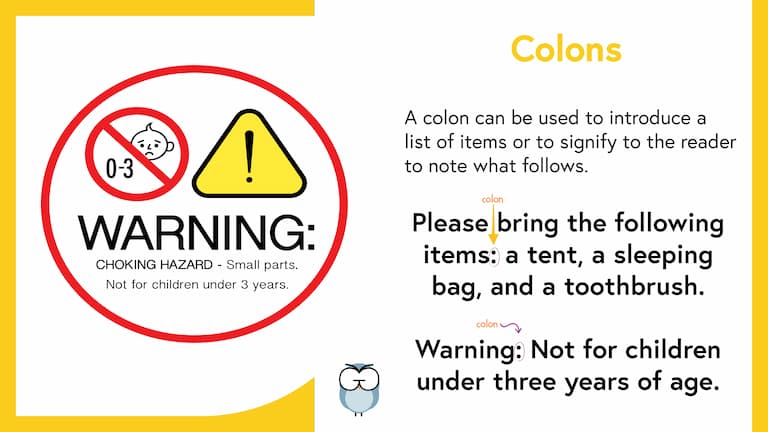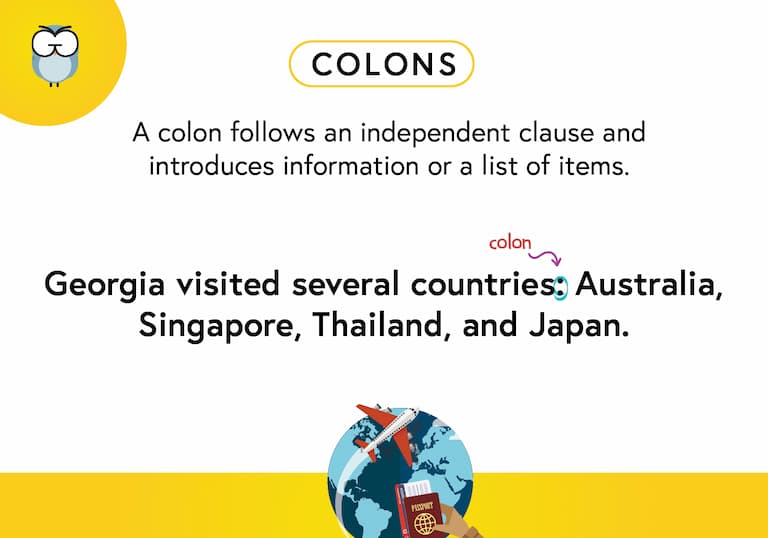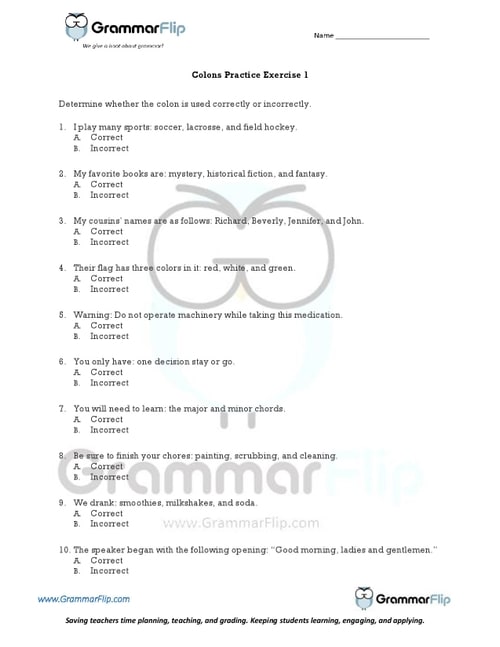What is a Colon?
A colon is a punctuation mark that follows an independent clause and introduces a list of items.
Some examples of colons would be the following:
Justine had forgotten the most important step in baking the cake: preheating the oven.
Make sure you are turning in all the parts of your project: your essay, your bibliography, and any rough drafts you wrote.
The soups of the day are as follows: broccoli cheddar, chicken noodle, and tomato bisque.
Georgia has traveled to several countries: Australia, New Zealand, Thailand, and Japan.
The following students will be team captains in our review game: Quentin, Jacqueline, Gustavo, and Daphne.
Long-Form Videos: Colons
Long-form instructional video lessons allow students to engage with grammar concepts in more depth and detail.
This format provides students with a stronger foundation and a more comprehensive understanding of colons.
Short-Form Videos: Colons
Short-form videos are an excellent way to review grammar concepts. Our two-minute instructional videos help students review the concept of colons to further solidify their understanding.
Memorable Images: Colons

The use of images to connect visual cues with concepts makes it simpler for students to grasp and remember key ideas. GrammarFlip’s memorable images create visual associations that make colons more engaging and easier to retain.
Definition Cards: Colons
Definition cards reinforce grammar concepts by providing clear and concise explanations that students can easily reference for quick review and better retention. GrammarFlip’s definintion cards help students review the concept of colons to further solidify their understanding.

When You Should Use Colons in Your Writing
Colons are great pieces of punctuation to use when you’re introducing a list of items or emphasizing information. They help direct the reader’s attention to what you are deeming to be important. Take the following examples (and, coincidentally, this use of a colon!):
You must bring three items with you: your test booklet, scrap paper, and a pencil.
By using a colon in this sentence, attention is placed upon the three items. The reader, upon seeing a colon, will naturally pause and focus on the list of items. Let’s take a look at another example:
Please be careful: The floor is wet.
In this sentence, the colon tends to say to the reader, “take note of what follows.” By taking note of the statement after the colon, the reader focuses on the fact that the floor is wet, and in effect with the use of your colon, you have made that reader more aware of what you were trying to convey.
Notice that this second example sentence was slightly different from the first example sentence. The information that follows the colon in the second example was a complete sentence (“The floor is wet.”) as opposed to the information that followed the colon in the first example (“your test booklet, scrap paper, and a pencil”). When the information that follows a colon is a complete sentence, then you should capitalize the first word. In the second example, we capitalize the word “The” because it begins a complete sentence.
Be sure not to confuse colons with semicolons; they are two completely different pieces of puncutation. Once you understand the difference between colon rules and semicolon rules, you’ll be able to use colons more effectively in your writing.
Download a Free Worksheet on Colons!
Click the image below to download your free worksheet on colons!

Need something more than just worksheets for your grammar instruction?
Explore More GrammarFlip Lessons!
Parts of Speech lessons provide the building blocks of grammar. GrammarFlip covers these topics in detail to ensure a solid foundation is built. First time learners and students seeking to review the parts of speech can both benefit from the instructional videos and slide show reviews.
Parts of the Sentence lessons are critical for understanding how the parts of speech function in language construction. From the basic to the advanced, these lessons will cover a wide range of grammar topics that can be used in any grade level or classroom.
Mechanics and Usage lessons equip students with the necessary skills to communicate clearly to all audiences. With a focus on the application of these concepts in student writing, these lessons tie together both simple constructions of grammar as well as the more complex such that any age or skill level of student will benefit.


